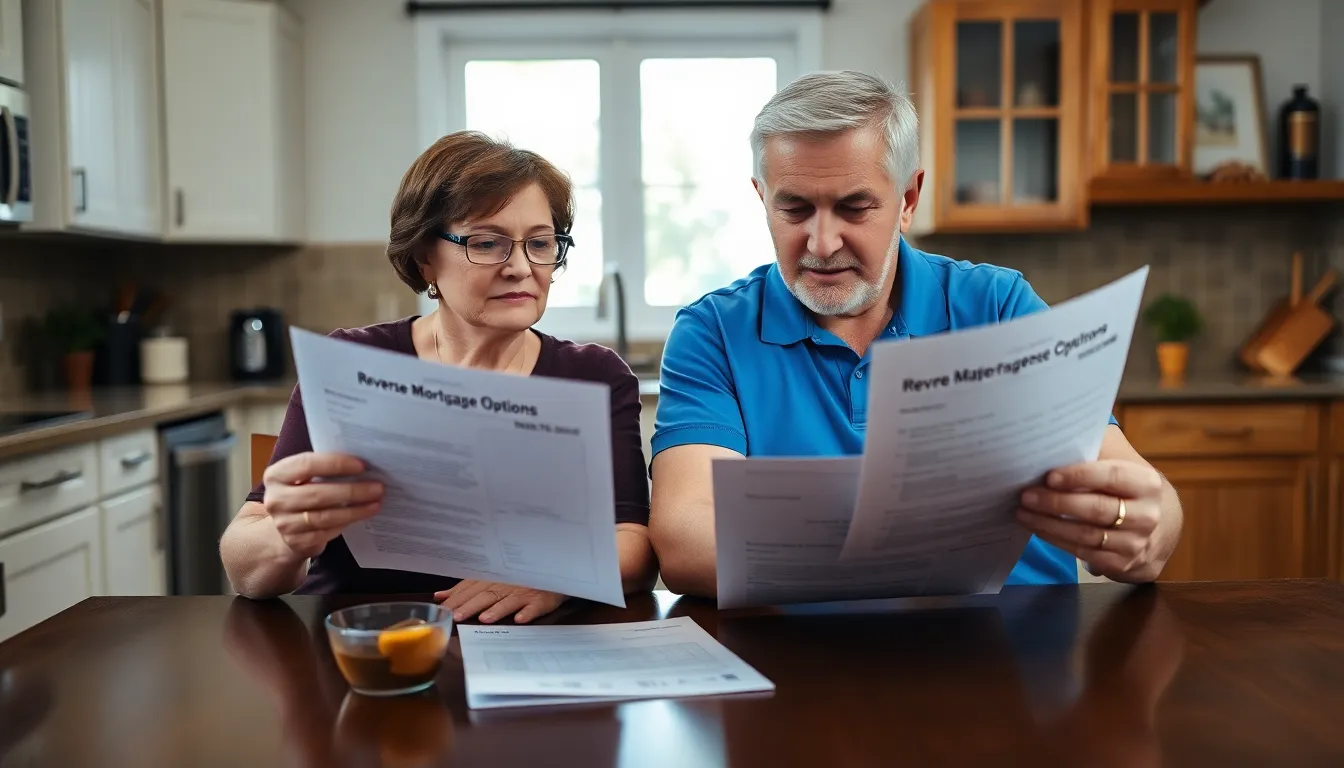Table of Contents
ToggleNavigating the world of reverse mortgages can feel like trying to solve a Rubik’s Cube blindfolded. But fear not! Understanding reverse mortgage payout options doesn’t have to be a headache. With the right knowledge, homeowners can unlock the hidden treasure in their homes and enjoy a little extra cash flow without the stress of monthly payments.
Picture this: you’re sipping coffee on your porch, enjoying the fruits of your labor, while your home works for you. Sounds dreamy, right? Reverse mortgages offer various payout options, from lump sums to monthly payments, giving homeowners the flexibility to choose what suits their lifestyle best. So, let’s dive into the ins and outs of these options and discover how to make the most of this financial tool. After all, who wouldn’t want to turn their home into a piggy bank?
Overview of Reverse Mortgages
Reverse mortgages allow homeowners, typically aged 62 and older, to convert home equity into cash. These financial products eliminate the need for monthly mortgage payments, preserving cash flow. Instead of making payments, homeowners receive funds based on their home’s value.
Homeowners can choose from several payout options to suit their needs. Options typically include lump sums, monthly payments, or a line of credit. Lump sum payouts offer immediate access to a large amount of cash, often used for major expenses. Monthly payments provide steady income, supporting regular expenses or living costs. Lines of credit function like a traditional credit card, allowing homeowners to withdraw funds as needed.
Eligibility for a reverse mortgage depends on factors like age, home equity, and residence type. Only primary residences qualify, which include single-family homes and some multi-unit properties. Lenders require homeowners to maintain their property and pay necessary taxes and insurance.
Receiving funds through a reverse mortgage can enhance financial stability. Homeowners facing retirement may find this an ideal solution for supplementing income. By tapping into home equity, they create opportunities for better cash management, helping to cover healthcare costs, repairs, or travel expenses.
Understanding the specifics of reverse mortgages ensures homeowners make informed decisions. Familiarity with different payout options allows for tailored financial planning. This tool can enhance retirement funding and provide peace of mind regarding financial needs.
Types of Reverse Mortgage Payout Options
Homeowners can select from several reverse mortgage payout options tailored to their financial needs. Understanding each choice helps in making informed decisions.
Lump Sum Payment
Lump sum payments provide immediate access to a substantial amount of cash. This option is often chosen for major expenses such as home renovations or debt repayment. Homeowners receive a single, upfront payment after closing the loan. It’s crucial to note that taking a lump sum affects the remaining equity in the home. Over time, accumulating interest and decreased equity may present challenges.
Monthly Installments
Monthly installments offer consistent income for homeowners, helping with regular expenses like healthcare or utilities. This structure provides stability, allowing for better cash flow management. The payout amount can be tailored based on individual needs and home equity. Recipients enjoy peace of mind knowing they receive predictable payments. It’s important to assess how this option impacts overall financial goals, especially during retirement.
Line of Credit
A line of credit provides flexibility, allowing homeowners to withdraw funds as needed. This option suits those who anticipate irregular expenses or want to manage cash flow proactively. Interest only accrues on the amount drawn, making it a cost-effective alternative. Homeowners can access their line of credit at any time, enhancing financial agility. Understanding the implications of withdrawal amounts helps in preserving home equity for the future.
Factors to Consider When Choosing Payout Options
Choosing the right reverse mortgage payout option hinges on several important factors. Homeowners must assess their financial situation and future needs.
Financial Goals
Financial goals serve as essential guiding principles for selecting payout options. Immediate cash needs often drive individuals to choose lump sum payouts. Those looking for regular cash flow might opt for monthly payments. A line of credit represents flexibility, appealing to those who prefer drawing funds as circumstances fluctuate. Understanding specific goals will refine the decision-making process.
Age and Equity
Age and home equity directly influence the available payout options. Homeowners aged 62 or older qualify for reverse mortgages, affecting eligibility and terms. Substantial home equity plays a crucial role, dictating the amount available for payouts. Options vary based on equity levels; higher equity typically provides more favorable payout choices. Homeowners should evaluate both their age and equity to align with financial needs.
Interest Rates
Interest rates significantly impact the total cost of a reverse mortgage and, thus, payout selections. Lower interest rates reduce overall borrowing costs, making payouts more attractive. Variable rates can lead to uncertainty in budgeting, while fixed rates offer stability. Evaluating current market conditions and potential rate fluctuations aids homeowners in making informed decisions about payouts. Interest rates shape the ultimate effectiveness of funding options in relation to financial plans.
Benefits and Drawbacks of Each Option
Each reverse mortgage payout option presents distinct benefits and drawbacks that homeowners must consider.
Lump sum payments deliver immediate access to a significant amount of cash, making them ideal for major expenses such as home renovations or medical bills. However, taking a lump sum may decrease the remaining home equity, which poses a risk for future financial needs.
Monthly payments supply a steady income that helps with regular expenses, offering stability and predictability. This option benefits those who prefer a consistent cash flow. The downside lies in the total payout sum, which can be lower compared to other options due to fixed monthly distributions.
Lines of credit provide flexibility that adapts to varying financial circumstances. With this choice, homeowners can withdraw funds on an as-needed basis while accruing interest solely on the amount drawn. This flexibility, however, might lead to unpredictable financial management if funds are not monitored closely.
Age and home equity play crucial roles in determining the best payout option. Older homeowners with substantial equity may find greater advantages in lump sums or monthly payments. Those lacking equity or in need of immediate cash flow should weigh their options carefully.
Interest rates significantly impact the attractiveness of each payout choice. They affect the overall cost of the reverse mortgage and the total amount disbursed. Homeowners must assess current market conditions to align their choice with their financial goals.
Selecting the right payout option requires examining individual financial needs, while consideration of age and equity remains essential. Making informed decisions paves the way for improved financial management in retirement.
Conclusion
Choosing the right payout option for a reverse mortgage is crucial for homeowners seeking financial stability in retirement. Each option—lump sum, monthly payments, and lines of credit—offers unique advantages tailored to different needs. By understanding these choices and considering factors like age and home equity, homeowners can make informed decisions that align with their financial goals.
It’s essential to evaluate personal circumstances and market conditions to select the most beneficial payout method. With the right approach, reverse mortgages can enhance cash flow and provide peace of mind during retirement years.




